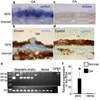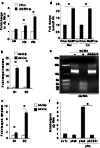DICER1 deficit induces Alu RNA toxicity in age-related macular degeneration
- PMID: 21297615
- PMCID: PMC3077055
- DOI: 10.1038/nature09830
DICER1 deficit induces Alu RNA toxicity in age-related macular degeneration
Abstract
Geographic atrophy (GA), an untreatable advanced form of age-related macular degeneration, results from retinal pigmented epithelium (RPE) cell degeneration. Here we show that the microRNA (miRNA)-processing enzyme DICER1 is reduced in the RPE of humans with GA, and that conditional ablation of Dicer1, but not seven other miRNA-processing enzymes, induces RPE degeneration in mice. DICER1 knockdown induces accumulation of Alu RNA in human RPE cells and Alu-like B1 and B2 RNAs in mouse RPE. Alu RNA is increased in the RPE of humans with GA, and this pathogenic RNA induces human RPE cytotoxicity and RPE degeneration in mice. Antisense oligonucleotides targeting Alu/B1/B2 RNAs prevent DICER1 depletion-induced RPE degeneration despite global miRNA downregulation. DICER1 degrades Alu RNA, and this digested Alu RNA cannot induce RPE degeneration in mice. These findings reveal a miRNA-independent cell survival function for DICER1 involving retrotransposon transcript degradation, show that Alu RNA can directly cause human pathology, and identify new targets for a major cause of blindness.
Figures





Comment in
-
Vision: Dicer leaps into view.Nature. 2011 Mar 17;471(7338):308-9. doi: 10.1038/471308a. Nature. 2011. PMID: 21412326 No abstract available.
References
-
- Ferrara N. Vascular endothelial growth factor and age-related macular degeneration: from basic science to therapy. Nat Med. 2010;16:1107–1111. - PubMed
-
- Ambati J, Ambati BK, Yoo SH, Ianchulev S, Adamis AP. Age-related macular degeneration: etiology, pathogenesis, and therapeutic strategies. Surv Ophthalmol. 2003;48:257–293. - PubMed
-
- Bernstein E, Caudy AA, Hammond SM, Hannon GJ. Role for a bidentate ribonuclease in the initiation step of RNA interference. Nature. 2001;409:363–366. - PubMed
Publication types
MeSH terms
Substances
Associated data
- Actions
- Actions
Grants and funding
- RC1EY020442/EY/NEI NIH HHS/United States
- P30 EY006360/EY/NEI NIH HHS/United States
- RC1 EY020442/EY/NEI NIH HHS/United States
- R01GM068414/GM/NIGMS NIH HHS/United States
- R01EY015240/EY/NEI NIH HHS/United States
- P30EY06360/EY/NEI NIH HHS/United States
- R01EY017182/EY/NEI NIH HHS/United States
- R01 EY020672/EY/NEI NIH HHS/United States
- T32HL091812/HL/NHLBI NIH HHS/United States
- R21AI076757/AI/NIAID NIH HHS/United States
- R01EY018836/EY/NEI NIH HHS/United States
- R01EY001545/EY/NEI NIH HHS/United States
- R01EY015422/EY/NEI NIH HHS/United States
- R01EY020672/EY/NEI NIH HHS/United States
- R01EY017950/EY/NEI NIH HHS/United States
- R01 EY018350/EY/NEI NIH HHS/United States
- P30EY003040/EY/NEI NIH HHS/United States
- HHMI/Howard Hughes Medical Institute/United States
- P30EY008571/EY/NEI NIH HHS/United States
- R21EY019778/EY/NEI NIH HHS/United States
- R01EY011123/EY/NEI NIH HHS/United States
- R21 EY019778/EY/NEI NIH HHS/United States
- R01EY018350/EY/NEI NIH HHS/United States
- R01 EY018836/EY/NEI NIH HHS/United States
- R01HD027215/HD/NICHD NIH HHS/United States
- NIHU10EY013729/EY/NEI NIH HHS/United States
- P30 EY021721/EY/NEI NIH HHS/United States
- P30 EY014800/EY/NEI NIH HHS/United States
LinkOut - more resources
Full Text Sources
Other Literature Sources
Medical
Molecular Biology Databases

